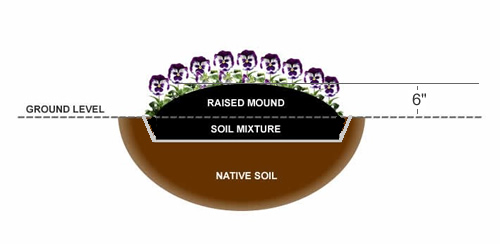When planted in properly prepared beds, annual flowers, also called "bedding plants," are the perfect choice for adding splashes of vibrant seasonal color in your landscape. Most annual plants prefer good drainage, so the best way to plant them in the garden is in "raised beds", or "raised mounds." Raised beds do not require edging or lumber, though edging may help to define the bed.
So here's some step-by-step instructions that can help you create the best performing and best looking flower beds in the neighborhood!
Tools you'll need:
Garden Rake / Hard Rake
Round Point or Flat Shovel
Leaf Rake
Roto Tiller (Optional)
Step-By-Step Instructions
STEP 1 - Mark the bed. Start by using marking paint, baking flour, or a garden hose to outline the shape of your new flower bed on the ground. You can create any shape you want: round, pie-shape, square, rectangular, triangular, peanut, kidney bean, oval, etc..
STEP 2 - Eliminate weeds. Pull or spray to kill any grass or weeds growing inside the outlined area of your flower bed with a solution of a glyphosate-based weed killer, such as Hi-Yield Killzall. Wet all foliage of grass and weeds thoroughly with weed killer. Allowing 2 hours for the spray to dry before planting. Always wear protective clothing and eye wear when spraying any chemical and follow mixing and application instructions on the product label.
STEP 3 - Trench the bed. Using a round pointed shovel or trenching shovel, trench around the outline of the flower bed to a depth of about 6 inches, placing soil removed from trench into a pile at the center region of the flower bed. Then use a rototiller or shovel to to till or turn the area inside the flowerbed to a depth of 6 inches or so.

STEP 4 - Add amendments. Evenly disperse a 4-inch layer of a light potting mix over the tilled soil and then till or turn these amendments into the soil. For larger beds, it might be necessary to bring in extra native top soil to raise your annual flower bed to a minimum height of 6" height at the center of the bed. You may also add other amendments to the mix, such as a flower food, vermiculite, cottonseed meal, fish emulsion ect.. The main thing you are trying to do is create a soil mixture that will be somewhat light, well-drained, but still hold moisture evenly.

STEP 5 - Form the mound. The goal is to form a smooth, gradually sloping mound. Use a garden rake to form a mound that will be 4 to 6 inches or more in height at the center of your flower bed and gradually taper to ground level at the perimeter of the flowerbed. Note, the larger the flowerbed the higher the mound should be at the center of the bed. I usually start by raking from the perimeter of the flowerbed inwards towards the center. A leaf rake or your hands can be used to put the finishing smooth touch on the mound. Now you are ready to plant.

STEP 6 - Spacing and setting plants. Remove plants from containers and space them over the surface of the planting bed at a distance as suggested on the plant tag. I always start with a single row around the perimeter of the flower bed. I then stagger plants in rows towards the inside of the perimeter row, and so on towards the center until the bed is full.
Note: To determine how many plants it will take to fill a flower bed you'll first need to determine total square feet of the planting bed. See How To Measure for Square Feet. Then you can can plug in the total square feet and the distance you will space the plants into this Plant Calculator to determine how many plants it will take to fill your flowerbed.
STEP 7 - Use a hand trowel or your hands to dig planting holes. Its a good idea to loosen roots at the bottom of the root ball before planting. While holding the plant so that the top edge of the rootball is level with the soil surface, gently back fill around the rootball with the soil you removed from the planting hole.
STEP 8 - When you have finished installing all of the plants in your flower bed, broadcast weed preventer granules, such as Hi Yield Herbicide Granules, over the surface of bed for season-long weed prevention.
STEP 9 - Feed the flowers. If you did not apply fertilizer when tilling your flower bed, you can apply a flower food at this time. I always use a slow-release flower food that provides season-long feeding. Alternatively you can feed them more regularly with a liquid flower food. Pansies, a winter flowering bedding plant, should be fertilized with a specialty Pansy Food containing "nitrate" form nitrogen.
NOTE - If you are really serious about the performance of your annual bedding plants, use a soil test kit to test the soil for nutrient deficiencies and for pH. This will tell you two critical details about your soil quality; pH and fertilizer needs. For many bedding plants, ideal soil pH is between 5.6 and 5.8.
Happy Flower Gardening!

